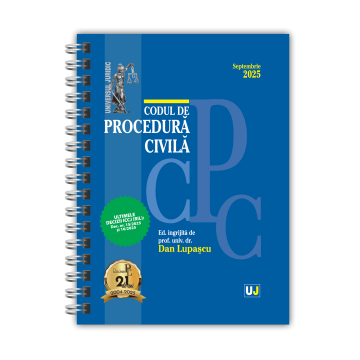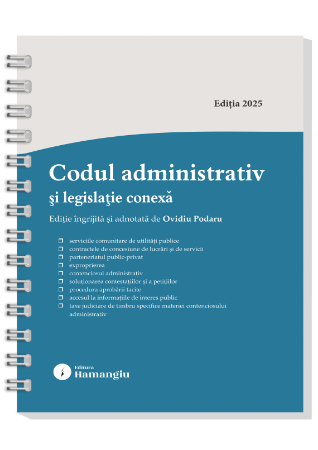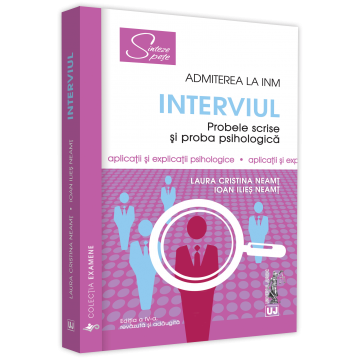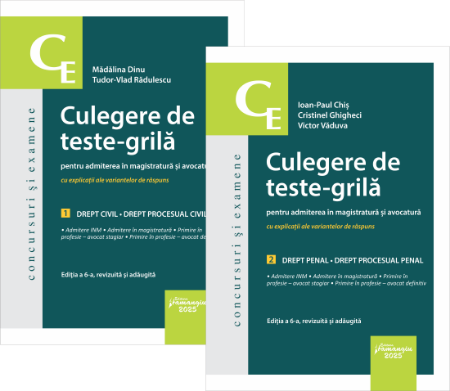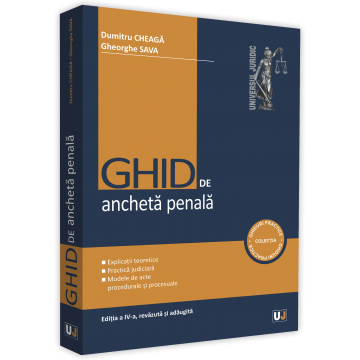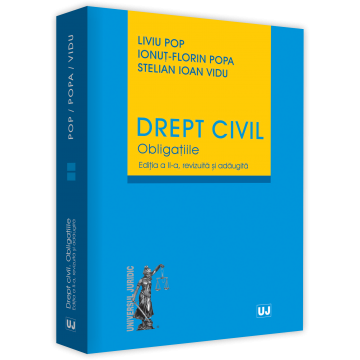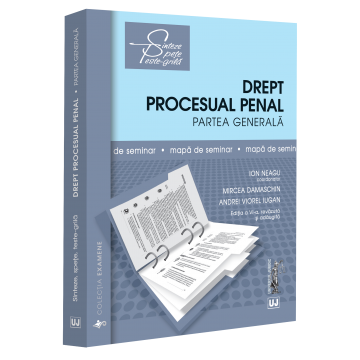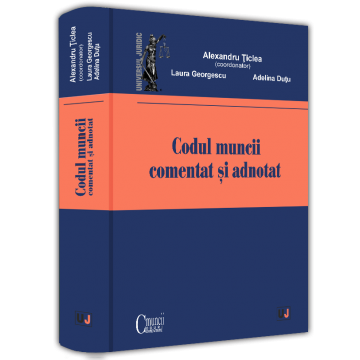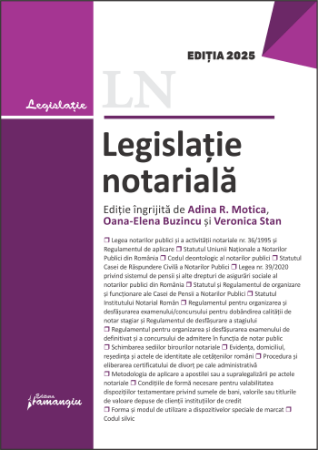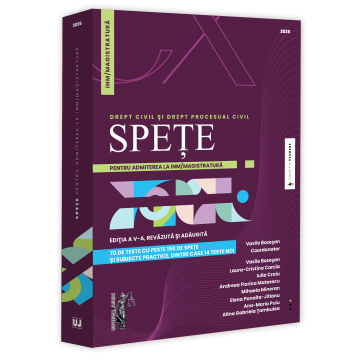ORDERS RECEIVED IN THE PERIOD 19.12.2025 - 07.01.2026 WILL BE FULFILLED STARTING ON 08.01.2026
 Civil law. Obligations. Seminar notebook. Second edition, revised and added - Ioan Ilies Neamt, Ioana Laura Toma-Dauceanu
Civil law. Obligations. Seminar notebook. Second edition, revised and added - Ioan Ilies Neamt, Ioana Laura Toma-Dauceanu

Publisher: Universul Juridic
Author: Ioan Ilies Neamt, Laura Toma-Dauceanu
Edition: a 2-a, revazuta si adaugita
Pages: 338
Publisher year: 2019
ISBN: 978-606-39-0333-5
Product Code:
9786063903335
Do you need help?
0745 200 357
- Description
- Download (1)
- Authors
- Content
- More details
- Reviews (0)
Description
The paper was conceived as a unique tool, meant to facilitate both learning for second year students in the subject of Civil Law. The obligations, as well as the recapitulation and structuring of the information for those already initiated in this matter.
The second edition brings developments of the theoretical part (being more widely analyzed some legal institutions), highlights the controversial aspects by exposing divergent opinions, increases the number of grids and cases and offers answers with explanations to the first 10 grids related to each topic.
Contents of the paper
The paper is structured in 12 Themes, each being organized in four parts. The first part contains a series of conceptual questions with reference to the part of the synthesis where the answers can be found. The second part contains a synthesis of the subject related to the seminar, being used countless examples to explain the institutions. The third part is focused on the evaluation through the grids, comprising 20 grids for each Theme, each grid can have as correct answer a variant, two, three or none. Finally, the last part is dedicated to evaluation through cases. There are 5 cases dedicated to each Theme, with a different level of difficulty. The final part of the paper includes the answers to the first 10 grids from each Topic, being, at the same time, offered explanations regarding the reasons why a certain variant is not correct.
Strengths
The synthesis part contains a structuring of the subject in an easy to remember format, which makes the paper an excellent tool for students who come into contact with the subject of Civil Law for the first time. Obligations and who want to form an overview before moving on to the detailed analysis. Also, the paper can be very useful for those who are preparing for bachelor's exams or admission to the legal professions, allowing a quick and structured recapitulation of the subject and a self-assessment. The multiple examples related to legal institutions, together with the accessible language and the structured character of the presentations, also facilitate the learning process. At the same time, the grids, together with the answers and explanations offered, the conceptual cases and questions allow a self-analysis of the level in which the subject was mastered.
Also, the paper tried to expose at the same time the opinion of the school from Bucharest and the one from Cluj, where they were divergent.
Target audience
The paper addresses:
- students preparing for the subject of Civil Law. Obligations;
- students preparing for the bachelor's exam;
- candidates who are preparing for admission to the INM or Bar;
- justice auditors preparing for the graduation exam;
- trainee magistrates who are preparing for the capacity exam;
- trainee lawyers who are preparing for the final exam;
- Last but not least, practitioners.
Product compliance information
The paper was conceived as a unique tool, meant to facilitate both learning for second year students in the subject of Civil Law. The obligations, as well as the recapitulation and structuring of the information for those already initiated in this matter.
The second edition brings developments of the theoretical part (being more widely analyzed some legal institutions), highlights the controversial aspects by exposing divergent opinions, increases the number of grids and cases and offers answers with explanations to the first 10 grids related to each topic.
Contents of the paper
The paper is structured in 12 Themes, each being organized in four parts. The first part contains a series of conceptual questions with reference to the part of the synthesis where the answers can be found. The second part contains a synthesis of the subject related to the seminar, being used countless examples to explain the institutions. The third part is focused on the evaluation through the grids, comprising 20 grids for each Theme, each grid can have as correct answer a variant, two, three or none. Finally, the last part is dedicated to evaluation through cases. There are 5 cases dedicated to each Theme, with a different level of difficulty. The final part of the paper includes the answers to the first 10 grids from each Topic, being, at the same time, offered explanations regarding the reasons why a certain variant is not correct.
Strengths
The synthesis part contains a structuring of the subject in an easy to remember format, which makes the paper an excellent tool for students who come into contact with the subject of Civil Law for the first time. Obligations and who want to form an overview before moving on to the detailed analysis. Also, the paper can be very useful for those who are preparing for bachelor's exams or admission to the legal professions, allowing a quick and structured recapitulation of the subject and a self-assessment. The multiple examples related to legal institutions, together with the accessible language and the structured character of the presentations, also facilitate the learning process. At the same time, the grids, together with the answers and explanations offered, the conceptual cases and questions allow a self-analysis of the level in which the subject was mastered.
Also, the paper tried to expose at the same time the opinion of the school from Bucharest and the one from Cluj, where they were divergent.
Target audience
The paper addresses:
- students preparing for the subject of Civil Law. Obligations;
- students preparing for the bachelor's exam;
- candidates who are preparing for admission to the INM or Bar;
- justice auditors preparing for the graduation exam;
- trainee magistrates who are preparing for the capacity exam;
- trainee lawyers who are preparing for the final exam;
- Last but not least, practitioners.
-
Civil law. Obligations. Seminar notebook. Second edition, revised and added - Ioan Ilies Neamt, Ioana Laura Toma-Dauceanu
Download
Ioan Ilies Neamt
Studies:
- graduate of the Faculty of Law within the "Babes Bolyai" University of Cluj Napoca, as well as of the master "National and European Business Law" within the same university in Cluj;
- graduate of the National Institute of Magistracy;
- doctor of law (civil law) 2017, qualifier summa cum laude, Faculty of Law, „Babes-Bolyai” University of Cluj-Napoca, under the coordination of Mr. acad. prof. univ. Dr. Liviu Pop.
Professional activity:
- judge at the Baia Mare Court (2013-2017), judge at the Maramures Tribunal (2018-present);
- associate professor of Civil Law. Obligations (bachelor level) and Private International Law (bachelor level), Faculty of Law, "Babes-Bolyai" University of Cluj-Napoca (February 2017-June 2020);
- associate professor in the subjects Medical Law (bachelor level - course and seminar), Public Health (bachelor level - course and seminar) and the Status of natural and legal person in the EU (master level - course and seminar), Barnutiu ”,“ Lucian Blaga ”University of Sibiu (academic year 2017-2018);
- visiting judge at the European Court of Human Rights (1 August 2013-31 October 2013);
- vice-president of UNJR (2015-present);
- founder, member of the scientific council and editor-in-chief of the publication "Revista de Dreptul Familiei".
Scientific activity:
a) author of the work: Collective action as a means of repairing the mass damages. An analysis from the perspective of comparative law, Universul Juridic Publishing House, Bucharest, 2017;
b) co-author of the works: Civil law. Obligations. Seminar book, Universul Juridic Publishing House, Bucharest, 2016 (1st ed.), 2018 (2nd ed. Revised and added); The interview. Admission to INM. Written tests and psychological test. Psychological applications and explanations, Universul Juridic Publishing House, Bucharest, 2017 (1st ed.), 2018 (2nd ed. Revised and added), 2019 (3rd ed. Revised and added);
c) author or, as the case may be, co-author, of several articles and studies published in “Revista de Dreptul Familiei”, “Revista Romana de Drept Privat”, “Revista Romana de Drept al Afaziilor” and “ACTA Universitatis Lucian Blaga. Jurisprudence ”.
Among the published articles and studies, we mention: “Can fear of future harm be a sufficient basis for current tortious civil liability? A look in the pandora's box ", in R.R.D.P. no. 3/2020; Old tools for new problems. Mass damage in the face of civil liability. Convergence or antinomy ?, in R.R.D.P. no. 2/2020; Article 80 para. (4) of the Code of Civil Procedure and the positive obligations of the state in the matter of fair trial, in R.R.D.P. no. 2/2020; Enforcement of the right to have personal relations with the minor. Illusion or reality, in R.D.F. no. 1-2 / 2019; Oblique action: an atypical form of representation, in R.R.D.P. no. 2/2019; Again about the conversion of the credit currency and the "freezing" of the exchange rate. Did Andriciuc change the cause in the R.R.D.P. no. 1/2019; Establishing the minor's home in case the parents do not live together. A legal-psychological analysis, in R.R.D.P. no. 3/2018 (co-author); The way of determining the class component in collective actions. Opt in, opt out or mandatory ?, in ACTA Universitatis "Lucian Blaga". Jurisprudence no. 1/2017; Classification of collective actions, in ACTA Universitatis "Lucian Blaga". Jurisprudence no. 2/2017; The historical and geographical evolution of collective action, in R.R.D.A. no. 4/2017; Abusive clauses. Credit currency conversion and "exchange rate freezing": solutions compatible with the analysis of abusive clauses, in R.R.D.P. no. 5/2016; The qualitative moment of concluding the contract. The essential elements of the contract, in the R.R.D.P. no. 4/2016; Class action at the gates of the fortress! (?), In I.Fl. Popa, D.A. Popescu (coord.), Liber Amicorum Liviu Pop. Romanian private law reform in the context of European legal federalism, Universul Juridic Publishing House, Bucharest, 2015; General aspects related to the competence of the trainee judge, in R.R.D.A. no. 4/2014; General considerations regarding the action regulated by art. 12 and 13 of Law no. 193/2000. Comparative law analysis, in R.R.D.P. no. 6/2013;
d) coordinator of the volume “Civil liability in the context of contemporary challenges” (R.R.D.P. no. 2/2020).
Awards:
- The “Simion Barnutiu” Award, granted by the Romanian Academy during the solemn meeting of the General Assembly of the Romanian Academy on December 12, 2019 for the work “Collective action as a means of repairing mass damages. An analysis from the perspective of comparative law ”, Universul Juridic Publishing House, Bucharest, 2017;
- The "Henri Capitant" Prize for the work "Collective action as a means of repairing mass damage. An analysis from the perspective of comparative law ”, Universul Juridic Publishing House, Bucharest, 2017. The award was given by Universul Juridic Publishing House and Revista Romana de Drefor Private, in collaboration with the National Union of Notaries Public in Romania and the Henri Capitant Association - Romania, for the best thesis or legal monograph of the year on private law topics;
- The "Octavian Capatana" award for the article "The qualitative moment of concluding the contract. The essential elements of the contract ”, published in the Romanian Journal of Private Law no. 4/2016. The award was given by Universul Juridic Publishing House and the Romanian Journal of Private Law, in collaboration with the National Union of Insolvency Practitioners in Romania, for the most original and valuable study published during 2016, in the pages of the Romanian Journal of Private Law.
Studies:
- graduate of the Faculty of Law within the "Babes Bolyai" University of Cluj Napoca, as well as of the master "National and European Business Law" within the same university in Cluj;
- graduate of the National Institute of Magistracy;
- doctor of law (civil law) 2017, qualifier summa cum laude, Faculty of Law, „Babes-Bolyai” University of Cluj-Napoca, under the coordination of Mr. acad. prof. univ. Dr. Liviu Pop.
Professional activity:
- judge at the Baia Mare Court (2013-2017), judge at the Maramures Tribunal (2018-present);
- associate professor of Civil Law. Obligations (bachelor level) and Private International Law (bachelor level), Faculty of Law, "Babes-Bolyai" University of Cluj-Napoca (February 2017-June 2020);
- associate professor in the subjects Medical Law (bachelor level - course and seminar), Public Health (bachelor level - course and seminar) and the Status of natural and legal person in the EU (master level - course and seminar), Barnutiu ”,“ Lucian Blaga ”University of Sibiu (academic year 2017-2018);
- visiting judge at the European Court of Human Rights (1 August 2013-31 October 2013);
- vice-president of UNJR (2015-present);
- founder, member of the scientific council and editor-in-chief of the publication "Revista de Dreptul Familiei".
Scientific activity:
a) author of the work: Collective action as a means of repairing the mass damages. An analysis from the perspective of comparative law, Universul Juridic Publishing House, Bucharest, 2017;
b) co-author of the works: Civil law. Obligations. Seminar book, Universul Juridic Publishing House, Bucharest, 2016 (1st ed.), 2018 (2nd ed. Revised and added); The interview. Admission to INM. Written tests and psychological test. Psychological applications and explanations, Universul Juridic Publishing House, Bucharest, 2017 (1st ed.), 2018 (2nd ed. Revised and added), 2019 (3rd ed. Revised and added);
c) author or, as the case may be, co-author, of several articles and studies published in “Revista de Dreptul Familiei”, “Revista Romana de Drept Privat”, “Revista Romana de Drept al Afaziilor” and “ACTA Universitatis Lucian Blaga. Jurisprudence ”.
Among the published articles and studies, we mention: “Can fear of future harm be a sufficient basis for current tortious civil liability? A look in the pandora's box ", in R.R.D.P. no. 3/2020; Old tools for new problems. Mass damage in the face of civil liability. Convergence or antinomy ?, in R.R.D.P. no. 2/2020; Article 80 para. (4) of the Code of Civil Procedure and the positive obligations of the state in the matter of fair trial, in R.R.D.P. no. 2/2020; Enforcement of the right to have personal relations with the minor. Illusion or reality, in R.D.F. no. 1-2 / 2019; Oblique action: an atypical form of representation, in R.R.D.P. no. 2/2019; Again about the conversion of the credit currency and the "freezing" of the exchange rate. Did Andriciuc change the cause in the R.R.D.P. no. 1/2019; Establishing the minor's home in case the parents do not live together. A legal-psychological analysis, in R.R.D.P. no. 3/2018 (co-author); The way of determining the class component in collective actions. Opt in, opt out or mandatory ?, in ACTA Universitatis "Lucian Blaga". Jurisprudence no. 1/2017; Classification of collective actions, in ACTA Universitatis "Lucian Blaga". Jurisprudence no. 2/2017; The historical and geographical evolution of collective action, in R.R.D.A. no. 4/2017; Abusive clauses. Credit currency conversion and "exchange rate freezing": solutions compatible with the analysis of abusive clauses, in R.R.D.P. no. 5/2016; The qualitative moment of concluding the contract. The essential elements of the contract, in the R.R.D.P. no. 4/2016; Class action at the gates of the fortress! (?), In I.Fl. Popa, D.A. Popescu (coord.), Liber Amicorum Liviu Pop. Romanian private law reform in the context of European legal federalism, Universul Juridic Publishing House, Bucharest, 2015; General aspects related to the competence of the trainee judge, in R.R.D.A. no. 4/2014; General considerations regarding the action regulated by art. 12 and 13 of Law no. 193/2000. Comparative law analysis, in R.R.D.P. no. 6/2013;
d) coordinator of the volume “Civil liability in the context of contemporary challenges” (R.R.D.P. no. 2/2020).
Awards:
- The “Simion Barnutiu” Award, granted by the Romanian Academy during the solemn meeting of the General Assembly of the Romanian Academy on December 12, 2019 for the work “Collective action as a means of repairing mass damages. An analysis from the perspective of comparative law ”, Universul Juridic Publishing House, Bucharest, 2017;
- The "Henri Capitant" Prize for the work "Collective action as a means of repairing mass damage. An analysis from the perspective of comparative law ”, Universul Juridic Publishing House, Bucharest, 2017. The award was given by Universul Juridic Publishing House and Revista Romana de Drefor Private, in collaboration with the National Union of Notaries Public in Romania and the Henri Capitant Association - Romania, for the best thesis or legal monograph of the year on private law topics;
- The "Octavian Capatana" award for the article "The qualitative moment of concluding the contract. The essential elements of the contract ”, published in the Romanian Journal of Private Law no. 4/2016. The award was given by Universul Juridic Publishing House and the Romanian Journal of Private Law, in collaboration with the National Union of Insolvency Practitioners in Romania, for the most original and valuable study published during 2016, in the pages of the Romanian Journal of Private Law.
TOPIC NO. 1. CIVIL OBLIGATIONS. GENERAL ASPECTS. / 12
Theoretical aspects / 12
General aspects related to civil obligations / 12
Notion / 12
The structure of the civil obligation / 12
Classification of civil obligations / 18
Sources of civil obligations / 22
General considerations / 22
Classification / 22
The contract as a source of civil obligations / 23
General considerations regarding the contract as a source of civil obligations / 23
Classification of contracts / 23
Practical aspects / 28
Grid tests / 28
Spete / 31
TOPIC NO. 2. CONCLUSION OF CONTRACTS / 38
Theoretical aspects / 38
Principles governing the conclusion of the contract / 38
Freedom to contract / 38
Freedom of form / 39
Formation of the contract / 40
Negotiation / 40
The offer-acceptance mechanism / 45
Peculiarities of concluding the non-negotiated contract / 49
Concluding the contract through the offer-acceptance mechanism. / 49
Protection of the party to whom the contract was imposed / 49
Practical aspects / 51
Grid tests / 51
Spete / 54
TOPIC NO. 3. EFFECTS OF THE CONTRACT / 62
Theoretical aspects / 62
Effects of the contract / 62
Interpretation of the contract / 62
The main rules of interpretation of the contract / 63
Subsidiary rules for the interpretation of the contract / 64
Mandatory force of the contract / 64
Notion / 64
Exceptions / 65
Relativity of contract effects / 67
Notion / 67
Apparent exceptions / 69
Real exceptions / 71
Opposability of the contract / 73
Notion / 73
Exceptions / 74
Practical aspects / 78
Grid tests / 78
Spete / 81
TOPIC NO. 4. EFFECTS SPECIFIC TO CONTRACTS
SINALAGMATICS / 86
Theoretical aspects / 86
Exception of non - execution / 86
Notion and conditions / 86
Effects / 87
Resolution, termination and reduction of benefits / 88
Notion and conditions / 88
Mode of operation / 89
Effects / 92
Fortuitous impossibility of execution. Risk in property transfer contracts / 93
Notion and conditions / 93
Effects / 94
Practical aspects / 96
Grid tests / 96
Spete / 99
TOPIC NO. 5. SOURCES OF OBLIGATIONS (II) / 105
Theoretical aspects / 105
The unilateral legal act as a source of obligations / 105
Notion / 105
The public promise of reward / 105
The lawful legal fact as a source of obligations / 106
Business management / 106
Undue payment / 110
Enrichment without just cause / 111
Practical aspects / 114
Grid tests / 114
Spete / 117
TOPIC NO. 6. CIVIL LIABILITY. CRIMINAL CIVIL LIABILITY FOR OWN DEED / 123
Theoretical aspects / 123
Civil liability / 123
Notion / 123
Fundamentals of civil liability / 124
Forms of civil liability / 125
Delinquent civil liability / 128
Tortious civil liability for one's own deed / 129
Illicit act / 130
Injury / 134
Causality report / 137
Vinovatia / 140
The tortious civil liability for the own deed of the legal person / 144
Practical aspects / 146
Grid tests / 146
Spete / 149
TOPIC NO. 7. CRIMINAL CIVIL LIABILITY FOR THE ACT OF ANOTHER, FOR THINGS AND FOR THE RUIN OF THE BUILDING. INJURY REPAIR / 157
Theoretical aspects / 156
Delinquent civil liability for damages caused by the deed of another / 157
Delinquent civil liability for damages caused by minors and judicial interdicts / 157
The tortious civil liability of the principals for the damages caused by the agents / 160
The correlation of the forms of responsibility for the deed of another person / 162
The right of recourse / 163
Delinquent civil liability for damages caused by things and animals / 164
Tortious civil liability for damages caused by animals / 164
Delinquent civil liability for damages caused by things / 166
Delinquent civil liability for damages caused by the ruin of the building / 168
Other cases of liability / 168
Special case of exemption / 169
Damage reparation in case of tortious civil liability / 169
The object of the repair / 169
Plurality of authors / 170
Incidental principles for damages / 171
Repair of damage by monetary equivalent / 173
Reparation of moral damages / 173
Reparation of bodily injury / 174
The relationship between the extent of the damage and the insurance liability or within the social insurances / 176
Prescription of the material right to action / 177
Practical aspects / 179
Grid tests / 179
Spete / 182
TOPIC NO. 8. OBLIGATIONS AFFECTED BY MODALITIES / 190
Theoretical aspects / 190
Obligations affected by modalities and complex obligations. Categories / 190
Obligations affected by the modalities / 190
Obligations affected by the condition / 190
Obligations affected by the term / 195
Complex obligations / 199
Conjunctive obligation / 204
Alternative obligations / 205
Optional obligations / 206
Practical aspects / 207
Grid tests / 207
Spete / 210
TOPIC NO. 9. TRANSMISSION AND TRANSFORMATION OF OBLIGATIONS / 216
Theoretical aspects / 216
Ways of transmitting obligations / 216
Assignment of receivable / 216
Subrogation in the creditor's rights by paying the debt / 220
Debt collection / 223
Assignment of contract / 226
Ways of transformation forcediilor. Novatia / 228
Practical aspects / 230
Grid tests / 230
Spete / 233
TOPIC NO. 10. PERFORMANCE OF OBLIGATIONS / 239
Theoretical aspects / 239
Direct execution (in kind) of contractual obligations / 239
The principle of execution in kind of obligations / 239
Plata / 239
Delay of the debtor / 246
Enforcement in kind of obligations / 248
Indirect execution of contractual obligations (execution by equivalent) / 250
Contractual civil liability / 250
Assessment of compensations (damages) / 253
The creditor's rights over the debtor's patrimony. / 257
Categories of creditor 's rights over the debtor' s patrimony / 257
Measures that can be taken by the creditor for the conservation of the debtor 's patrimony / 257
Oblique action (indirect or subrogatory) / 258
Paulian action (revocation) / 260
Practical aspects / 263
Grid tests / 263
Spete / 266
TOPIC NO. 11. TERMINATION OF OBLIGATIONS / 274
Theoretical aspects / 274
Compensation / 274
Notion and conditions / 274
Effects / 275
Confusion / 277
Notion and conditions / 277
Effects / 277
Giving in payment / 277
Notion and conditions / 277
Effects / 278
Debt remission / 279
Notion and conditions / 279
Effects / 280
Fortuitous impossibility of execution / 280
Notion and conditions / 280
Effects / 281
Practical aspects / 282
Grid tests / 282
Spete / 285
TOPIC NO. 12. WARRANTIES OF OBLIGATIONS / 292
Theoretical aspects / 292
Guarantee / 292
Notion and conditions / 292
Characters of the suretyship contract / 293
The effects of surety / 294
Termination of surety / 296
Privileges / 297
Notion / 297
Legal characters / 298
Mortgage / 299
Notion and conditions / 299
Legal characters / 302
Effects / 302
Gajul / 303
Notion / 303
Legal characters / 303
Effects / 304
Right of retention / 305
Notion and conditions / 305
Effects / 306
Practical aspects / 313
Grid tests / 313
Spete / 315
Grid solutions / 320
Theoretical aspects / 12
General aspects related to civil obligations / 12
Notion / 12
The structure of the civil obligation / 12
Classification of civil obligations / 18
Sources of civil obligations / 22
General considerations / 22
Classification / 22
The contract as a source of civil obligations / 23
General considerations regarding the contract as a source of civil obligations / 23
Classification of contracts / 23
Practical aspects / 28
Grid tests / 28
Spete / 31
TOPIC NO. 2. CONCLUSION OF CONTRACTS / 38
Theoretical aspects / 38
Principles governing the conclusion of the contract / 38
Freedom to contract / 38
Freedom of form / 39
Formation of the contract / 40
Negotiation / 40
The offer-acceptance mechanism / 45
Peculiarities of concluding the non-negotiated contract / 49
Concluding the contract through the offer-acceptance mechanism. / 49
Protection of the party to whom the contract was imposed / 49
Practical aspects / 51
Grid tests / 51
Spete / 54
TOPIC NO. 3. EFFECTS OF THE CONTRACT / 62
Theoretical aspects / 62
Effects of the contract / 62
Interpretation of the contract / 62
The main rules of interpretation of the contract / 63
Subsidiary rules for the interpretation of the contract / 64
Mandatory force of the contract / 64
Notion / 64
Exceptions / 65
Relativity of contract effects / 67
Notion / 67
Apparent exceptions / 69
Real exceptions / 71
Opposability of the contract / 73
Notion / 73
Exceptions / 74
Practical aspects / 78
Grid tests / 78
Spete / 81
TOPIC NO. 4. EFFECTS SPECIFIC TO CONTRACTS
SINALAGMATICS / 86
Theoretical aspects / 86
Exception of non - execution / 86
Notion and conditions / 86
Effects / 87
Resolution, termination and reduction of benefits / 88
Notion and conditions / 88
Mode of operation / 89
Effects / 92
Fortuitous impossibility of execution. Risk in property transfer contracts / 93
Notion and conditions / 93
Effects / 94
Practical aspects / 96
Grid tests / 96
Spete / 99
TOPIC NO. 5. SOURCES OF OBLIGATIONS (II) / 105
Theoretical aspects / 105
The unilateral legal act as a source of obligations / 105
Notion / 105
The public promise of reward / 105
The lawful legal fact as a source of obligations / 106
Business management / 106
Undue payment / 110
Enrichment without just cause / 111
Practical aspects / 114
Grid tests / 114
Spete / 117
TOPIC NO. 6. CIVIL LIABILITY. CRIMINAL CIVIL LIABILITY FOR OWN DEED / 123
Theoretical aspects / 123
Civil liability / 123
Notion / 123
Fundamentals of civil liability / 124
Forms of civil liability / 125
Delinquent civil liability / 128
Tortious civil liability for one's own deed / 129
Illicit act / 130
Injury / 134
Causality report / 137
Vinovatia / 140
The tortious civil liability for the own deed of the legal person / 144
Practical aspects / 146
Grid tests / 146
Spete / 149
TOPIC NO. 7. CRIMINAL CIVIL LIABILITY FOR THE ACT OF ANOTHER, FOR THINGS AND FOR THE RUIN OF THE BUILDING. INJURY REPAIR / 157
Theoretical aspects / 156
Delinquent civil liability for damages caused by the deed of another / 157
Delinquent civil liability for damages caused by minors and judicial interdicts / 157
The tortious civil liability of the principals for the damages caused by the agents / 160
The correlation of the forms of responsibility for the deed of another person / 162
The right of recourse / 163
Delinquent civil liability for damages caused by things and animals / 164
Tortious civil liability for damages caused by animals / 164
Delinquent civil liability for damages caused by things / 166
Delinquent civil liability for damages caused by the ruin of the building / 168
Other cases of liability / 168
Special case of exemption / 169
Damage reparation in case of tortious civil liability / 169
The object of the repair / 169
Plurality of authors / 170
Incidental principles for damages / 171
Repair of damage by monetary equivalent / 173
Reparation of moral damages / 173
Reparation of bodily injury / 174
The relationship between the extent of the damage and the insurance liability or within the social insurances / 176
Prescription of the material right to action / 177
Practical aspects / 179
Grid tests / 179
Spete / 182
TOPIC NO. 8. OBLIGATIONS AFFECTED BY MODALITIES / 190
Theoretical aspects / 190
Obligations affected by modalities and complex obligations. Categories / 190
Obligations affected by the modalities / 190
Obligations affected by the condition / 190
Obligations affected by the term / 195
Complex obligations / 199
Conjunctive obligation / 204
Alternative obligations / 205
Optional obligations / 206
Practical aspects / 207
Grid tests / 207
Spete / 210
TOPIC NO. 9. TRANSMISSION AND TRANSFORMATION OF OBLIGATIONS / 216
Theoretical aspects / 216
Ways of transmitting obligations / 216
Assignment of receivable / 216
Subrogation in the creditor's rights by paying the debt / 220
Debt collection / 223
Assignment of contract / 226
Ways of transformation forcediilor. Novatia / 228
Practical aspects / 230
Grid tests / 230
Spete / 233
TOPIC NO. 10. PERFORMANCE OF OBLIGATIONS / 239
Theoretical aspects / 239
Direct execution (in kind) of contractual obligations / 239
The principle of execution in kind of obligations / 239
Plata / 239
Delay of the debtor / 246
Enforcement in kind of obligations / 248
Indirect execution of contractual obligations (execution by equivalent) / 250
Contractual civil liability / 250
Assessment of compensations (damages) / 253
The creditor's rights over the debtor's patrimony. / 257
Categories of creditor 's rights over the debtor' s patrimony / 257
Measures that can be taken by the creditor for the conservation of the debtor 's patrimony / 257
Oblique action (indirect or subrogatory) / 258
Paulian action (revocation) / 260
Practical aspects / 263
Grid tests / 263
Spete / 266
TOPIC NO. 11. TERMINATION OF OBLIGATIONS / 274
Theoretical aspects / 274
Compensation / 274
Notion and conditions / 274
Effects / 275
Confusion / 277
Notion and conditions / 277
Effects / 277
Giving in payment / 277
Notion and conditions / 277
Effects / 278
Debt remission / 279
Notion and conditions / 279
Effects / 280
Fortuitous impossibility of execution / 280
Notion and conditions / 280
Effects / 281
Practical aspects / 282
Grid tests / 282
Spete / 285
TOPIC NO. 12. WARRANTIES OF OBLIGATIONS / 292
Theoretical aspects / 292
Guarantee / 292
Notion and conditions / 292
Characters of the suretyship contract / 293
The effects of surety / 294
Termination of surety / 296
Privileges / 297
Notion / 297
Legal characters / 298
Mortgage / 299
Notion and conditions / 299
Legal characters / 302
Effects / 302
Gajul / 303
Notion / 303
Legal characters / 303
Effects / 304
Right of retention / 305
Notion and conditions / 305
Effects / 306
Practical aspects / 313
Grid tests / 313
Spete / 315
Grid solutions / 320
Description
The paper was conceived as a unique tool, meant to facilitate both learning for second year students in the subject of Civil Law. The obligations, as well as the recapitulation and structuring of the information for those already initiated in this matter.
The second edition brings developments of the theoretical part (being more widely analyzed some legal institutions), highlights the controversial aspects by exposing divergent opinions, increases the number of grids and cases and offers answers with explanations to the first 10 grids related to each topic.
Contents of the paper
The paper is structured in 12 Themes, each being organized in four parts. The first part contains a series of conceptual questions with reference to the part of the synthesis where the answers can be found. The second part contains a synthesis of the subject related to the seminar, being used countless examples to explain the institutions. The third part is focused on the evaluation through the grids, comprising 20 grids for each Theme, each grid can have as correct answer a variant, two, three or none. Finally, the last part is dedicated to evaluation through cases. There are 5 cases dedicated to each Theme, with a different level of difficulty. The final part of the paper includes the answers to the first 10 grids from each Topic, being, at the same time, offered explanations regarding the reasons why a certain variant is not correct.
Strengths
The synthesis part contains a structuring of the subject in an easy to remember format, which makes the paper an excellent tool for students who come into contact with the subject of Civil Law for the first time. Obligations and who want to form an overview before moving on to the detailed analysis. Also, the paper can be very useful for those who are preparing for bachelor's exams or admission to the legal professions, allowing a quick and structured recapitulation of the subject and a self-assessment. The multiple examples related to legal institutions, together with the accessible language and the structured character of the presentations, also facilitate the learning process. At the same time, the grids, together with the answers and explanations offered, the conceptual cases and questions allow a self-analysis of the level in which the subject was mastered.
Also, the paper tried to expose at the same time the opinion of the school from Bucharest and the one from Cluj, where they were divergent.
Target audience
The paper addresses:
- students preparing for the subject of Civil Law. Obligations;
- students preparing for the bachelor's exam;
- candidates who are preparing for admission to the INM or Bar;
- justice auditors preparing for the graduation exam;
- trainee magistrates who are preparing for the capacity exam;
- trainee lawyers who are preparing for the final exam;
- Last but not least, practitioners.
The paper was conceived as a unique tool, meant to facilitate both learning for second year students in the subject of Civil Law. The obligations, as well as the recapitulation and structuring of the information for those already initiated in this matter.
The second edition brings developments of the theoretical part (being more widely analyzed some legal institutions), highlights the controversial aspects by exposing divergent opinions, increases the number of grids and cases and offers answers with explanations to the first 10 grids related to each topic.
Contents of the paper
The paper is structured in 12 Themes, each being organized in four parts. The first part contains a series of conceptual questions with reference to the part of the synthesis where the answers can be found. The second part contains a synthesis of the subject related to the seminar, being used countless examples to explain the institutions. The third part is focused on the evaluation through the grids, comprising 20 grids for each Theme, each grid can have as correct answer a variant, two, three or none. Finally, the last part is dedicated to evaluation through cases. There are 5 cases dedicated to each Theme, with a different level of difficulty. The final part of the paper includes the answers to the first 10 grids from each Topic, being, at the same time, offered explanations regarding the reasons why a certain variant is not correct.
Strengths
The synthesis part contains a structuring of the subject in an easy to remember format, which makes the paper an excellent tool for students who come into contact with the subject of Civil Law for the first time. Obligations and who want to form an overview before moving on to the detailed analysis. Also, the paper can be very useful for those who are preparing for bachelor's exams or admission to the legal professions, allowing a quick and structured recapitulation of the subject and a self-assessment. The multiple examples related to legal institutions, together with the accessible language and the structured character of the presentations, also facilitate the learning process. At the same time, the grids, together with the answers and explanations offered, the conceptual cases and questions allow a self-analysis of the level in which the subject was mastered.
Also, the paper tried to expose at the same time the opinion of the school from Bucharest and the one from Cluj, where they were divergent.
Target audience
The paper addresses:
- students preparing for the subject of Civil Law. Obligations;
- students preparing for the bachelor's exam;
- candidates who are preparing for admission to the INM or Bar;
- justice auditors preparing for the graduation exam;
- trainee magistrates who are preparing for the capacity exam;
- trainee lawyers who are preparing for the final exam;
- Last but not least, practitioners.
If you want to express your opinion about this product you can add a review.
write a review

![Civil law. Obligations. Seminar notebook. Second edition, revised and added - Ioan Ilies Neamt, Ioana Laura Toma-Dauceanu [1] Civil law. Obligations. Seminar notebook. Second edition, revised and added - Ioan Ilies Neamt, Ioana Laura Toma-Dauceanu [1]](https://gomagcdn.ro/domains/editurauniversitara.ro/files/product/large/civil-law-obligations-seminar-notebook-second-edition-revised-and-added-ioan-ilies-neamt-ioana-laura-toma-dauceanu-3165-3395.png)

